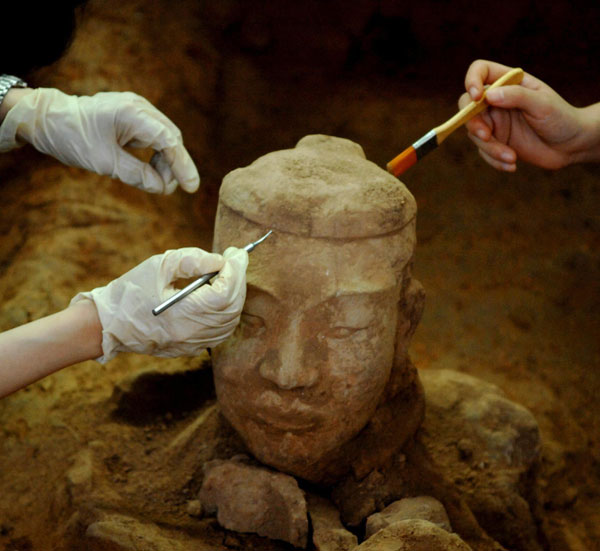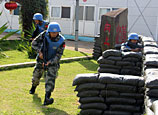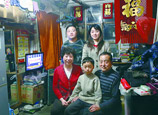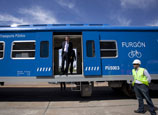
 |
| Scientists clean up unearthed terracotta worriors in Xi'an, Shaanxi province on Dec 20, 2012. (Photo/Xinhua) |
The Otago Museum in New Zealand announced a plan to use air curtain technology to resolve draughty conditions in the museum, Otago Daily Times reported in September. However, the air curtain only worked as an alternative solution to prevent cold air entering and causing visitor discomfort.
The reason behind the less-frequent use of air curtains to directly protect relics is, on the one hand, that air pollution in other countries is not so severe, and on the other hand there are fewer historic pit sites outside China that are especially suited for air curtains, Gu Zhaolin said.
Gu, as a prominent environmental expert, did not pay any attention to historic preservation projects before he visited the Han Yang Ling Mausoleum in 2006.
The Han Yang Ling Mausoleum is the largest underground archaeology museum in China. Most relics are kept in the primitive environment in the pit, separated from visitors by windows.
"But windows cannot preserve the environment completely, and they are much more expensive," Gu said.
As a result, Gu came up with the idea of air curtains, an already mature technology.
"The underground relics need a different environment than tourists, just like food in a freezer needs a lower temperature than the consumers. So I was inspired by the air curtain system in the freezers - why can't we separate the environment using an air curtain, so the control of the environment is possible without influencing people viewing the site," Gu said.
Different from the air curtain in freezers, the air curtain in the museum not only adjusts the internal and external temperatures, it also keeps pollutants outside.
As the pit holding the Terracotta Warriors is lower than the viewing gallery, Gu plans to install the air curtain system between the pit and the gallery so that clean air can be delivered into the pit under the air curtain without being mixed with the air above the tourist area.
"Most researchers in the museums have backgrounds like chemistry and archaeology, and few have a knowledge of physics. So interdisciplinary studies bring some fresh ideas to solve old environmental problems," Gu said.
Gu said that his team, which includes physicists, chemists and relic experts, has finished the system design for an air-curtain system for the Terracotta Warriors.
The air curtain system will first be tested in a model pit before being used in the heritage site, he said.
Gu said there are still some difficulties to overcome in existing museums like the Emperor Qin Shihuang's Mausoleum Site Museum.
Besides the Terracotta Warriors, the pit itself is a relic too, because it shows evidence of a fire, which according to legend was started by Xiang Yu, the king of Chu, after he beat Qin's army. "So it offers tough challenges for scientists to install an air curtain that both covers the whole area and keeps the completeness of the tunnels," Gu said.
Gu added that reforming the existing museum facilitates is not his first goal.
"The best application of an air curtain is to add it into the design of a new museum, so that the air curtain becomes a part of the whole, which both protects the relics and ensures a comfortable exhibiting environment," he said.

















 Village teacher with his back basket
Village teacher with his back basket


![]()
